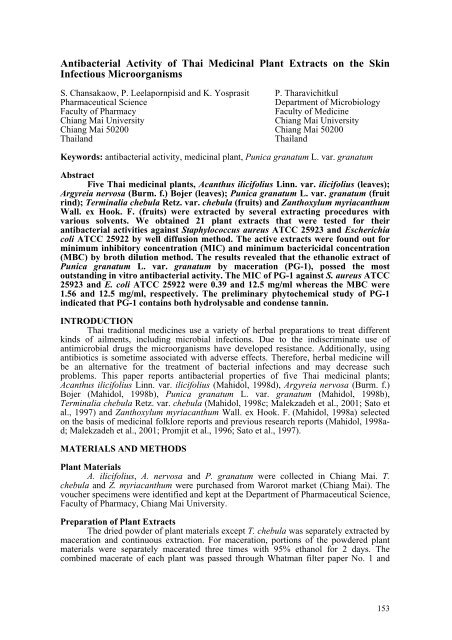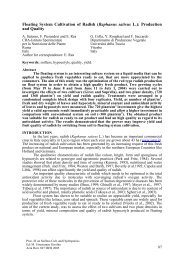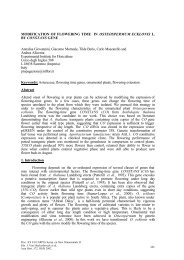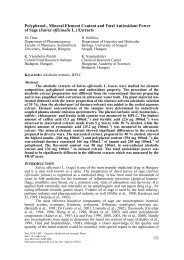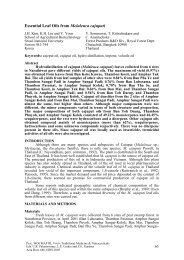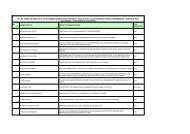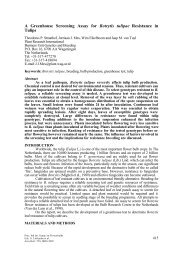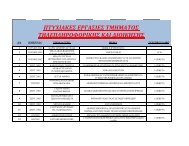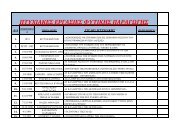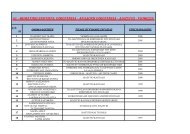Antibacterial Activity of Thai Medicinal Plant Extracts on the Skin ...
Antibacterial Activity of Thai Medicinal Plant Extracts on the Skin ...
Antibacterial Activity of Thai Medicinal Plant Extracts on the Skin ...
Create successful ePaper yourself
Turn your PDF publications into a flip-book with our unique Google optimized e-Paper software.
<str<strong>on</strong>g>Antibacterial</str<strong>on</strong>g> <str<strong>on</strong>g>Activity</str<strong>on</strong>g> <str<strong>on</strong>g>of</str<strong>on</strong>g> <str<strong>on</strong>g>Thai</str<strong>on</strong>g> <str<strong>on</strong>g>Medicinal</str<strong>on</strong>g> <str<strong>on</strong>g>Plant</str<strong>on</strong>g> <str<strong>on</strong>g>Extracts</str<strong>on</strong>g> <strong>on</strong> <strong>the</strong> <strong>Skin</strong><br />
Infectious Microorganisms<br />
S. Chansakaow, P. Leelapornpisid and K. Yosprasit<br />
Pharmaceutical Science<br />
Faculty <str<strong>on</strong>g>of</str<strong>on</strong>g> Pharmacy<br />
Chiang Mai University<br />
Chiang Mai 50200<br />
<str<strong>on</strong>g>Thai</str<strong>on</strong>g>land<br />
P. Tharavichitkul<br />
Department <str<strong>on</strong>g>of</str<strong>on</strong>g> Microbiology<br />
Faculty <str<strong>on</strong>g>of</str<strong>on</strong>g> Medicine<br />
Chiang Mai University<br />
Chiang Mai 50200<br />
<str<strong>on</strong>g>Thai</str<strong>on</strong>g>land<br />
Keywords: antibacterial activity, medicinal plant, Punica granatum L. var. granatum<br />
Abstract<br />
Five <str<strong>on</strong>g>Thai</str<strong>on</strong>g> medicinal plants, Acanthus ilicifolius Linn. var. ilicifolius (leaves);<br />
Argyreia nervosa (Burm. f.) Bojer (leaves); Punica granatum L. var. granatum (fruit<br />
rind); Terminalia chebula Retz. var. chebula (fruits) and Zanthoxylum myriacanthum<br />
Wall. ex Hook. F. (fruits) were extracted by several extracting procedures with<br />
various solvents. We obtained 21 plant extracts that were tested for <strong>the</strong>ir<br />
antibacterial activities against Staphylococcus aureus ATCC 25923 and Escherichia<br />
coli ATCC 25922 by well diffusi<strong>on</strong> method. The active extracts were found out for<br />
minimum inhibitory c<strong>on</strong>centrati<strong>on</strong> (MIC) and minimum bactericidal c<strong>on</strong>centrati<strong>on</strong><br />
(MBC) by broth diluti<strong>on</strong> method. The results revealed that <strong>the</strong> ethanolic extract <str<strong>on</strong>g>of</str<strong>on</strong>g><br />
Punica granatum L. var. granatum by macerati<strong>on</strong> (PG-1), possed <strong>the</strong> most<br />
outstanding in vitro antibacterial activity. The MIC <str<strong>on</strong>g>of</str<strong>on</strong>g> PG-1 against S. aureus ATCC<br />
25923 and E. coli ATCC 25922 were 0.39 and 12.5 mg/ml whereas <strong>the</strong> MBC were<br />
1.56 and 12.5 mg/ml, respectively. The preliminary phytochemical study <str<strong>on</strong>g>of</str<strong>on</strong>g> PG-1<br />
indicated that PG-1 c<strong>on</strong>tains both hydrolysable and c<strong>on</strong>dense tannin.<br />
INTRODUCTION<br />
<str<strong>on</strong>g>Thai</str<strong>on</strong>g> traditi<strong>on</strong>al medicines use a variety <str<strong>on</strong>g>of</str<strong>on</strong>g> herbal preparati<strong>on</strong>s to treat different<br />
kinds <str<strong>on</strong>g>of</str<strong>on</strong>g> ailments, including microbial infecti<strong>on</strong>s. Due to <strong>the</strong> indiscriminate use <str<strong>on</strong>g>of</str<strong>on</strong>g><br />
antimicrobial drugs <strong>the</strong> microorganisms have developed resistance. Additi<strong>on</strong>ally, using<br />
antibiotics is sometime associated with adverse effects. Therefore, herbal medicine will<br />
be an alternative for <strong>the</strong> treatment <str<strong>on</strong>g>of</str<strong>on</strong>g> bacterial infecti<strong>on</strong>s and may decrease such<br />
problems. This paper reports antibacterial properties <str<strong>on</strong>g>of</str<strong>on</strong>g> five <str<strong>on</strong>g>Thai</str<strong>on</strong>g> medicinal plants;<br />
Acanthus ilicifolius Linn. var. ilicifolius (Mahidol, 1998d), Argyreia nervosa (Burm. f.)<br />
Bojer (Mahidol, 1998b), Punica granatum L. var. granatum (Mahidol, 1998b),<br />
Terminalia chebula Retz. var. chebula (Mahidol, 1998c; Malekzadeh et al., 2001; Sato et<br />
al., 1997) and Zanthoxylum myriacanthum Wall. ex Hook. F. (Mahidol, 1998a) selected<br />
<strong>on</strong> <strong>the</strong> basis <str<strong>on</strong>g>of</str<strong>on</strong>g> medicinal folklore reports and previous research reports (Mahidol, 1998ad;<br />
Malekzadeh et al., 2001; Promjit et al., 1996; Sato et al., 1997).<br />
MATERIALS AND METHODS<br />
<str<strong>on</strong>g>Plant</str<strong>on</strong>g> Materials<br />
A. ilicifolius, A. nervosa and P. granatum were collected in Chiang Mai. T.<br />
chebula and Z. myriacanthum were purchased from Warorot market (Chiang Mai). The<br />
voucher specimens were identified and kept at <strong>the</strong> Department <str<strong>on</strong>g>of</str<strong>on</strong>g> Pharmaceutical Science,<br />
Faculty <str<strong>on</strong>g>of</str<strong>on</strong>g> Pharmacy, Chiang Mai University.<br />
Preparati<strong>on</strong> <str<strong>on</strong>g>of</str<strong>on</strong>g> <str<strong>on</strong>g>Plant</str<strong>on</strong>g> <str<strong>on</strong>g>Extracts</str<strong>on</strong>g><br />
The dried powder <str<strong>on</strong>g>of</str<strong>on</strong>g> plant materials except T. chebula was separately extracted by<br />
macerati<strong>on</strong> and c<strong>on</strong>tinuous extracti<strong>on</strong>. For macerati<strong>on</strong>, porti<strong>on</strong>s <str<strong>on</strong>g>of</str<strong>on</strong>g> <strong>the</strong> powdered plant<br />
materials were separately macerated three times with 95% ethanol for 2 days. The<br />
combined macerate <str<strong>on</strong>g>of</str<strong>on</strong>g> each plant was passed through Whatman filter paper No. 1 and<br />
153
evarporated to dryness in vacuo using rotary evaporator at 45°C. For c<strong>on</strong>tinuous<br />
extracti<strong>on</strong>, porti<strong>on</strong>s <str<strong>on</strong>g>of</str<strong>on</strong>g> <strong>the</strong> powdered plant materials were separately extracted until<br />
exhausted by soxhlet apparatus using n-hexane, chlor<str<strong>on</strong>g>of</str<strong>on</strong>g>orm and 95% ethanol,<br />
respectively. The extract soluti<strong>on</strong>s were filtered and <strong>the</strong>n <strong>the</strong> solvents were removed by<br />
evaporati<strong>on</strong> at 45°C to yield <strong>the</strong> n-hexane extract, chlor<str<strong>on</strong>g>of</str<strong>on</strong>g>orm extract and ethanol extract<br />
<str<strong>on</strong>g>of</str<strong>on</strong>g> four kinds <str<strong>on</strong>g>of</str<strong>on</strong>g> plant materials.<br />
For T. chebula, extracti<strong>on</strong> was d<strong>on</strong>e by c<strong>on</strong>tinuous extracti<strong>on</strong> and <strong>the</strong> solvent<br />
extracti<strong>on</strong> method adopted from Sato et al. (1997). C<strong>on</strong>tinuous extracti<strong>on</strong> was d<strong>on</strong>e by<br />
using methanol as solvent. For solvent extracti<strong>on</strong> method (Sato et al., 1997), <strong>the</strong> powder<br />
<str<strong>on</strong>g>of</str<strong>on</strong>g> T. chebula was extracted three times with 50% ethanol under reflux for 2 hours. The<br />
extract soluti<strong>on</strong>s were combined, c<strong>on</strong>centrated in vacuo to evaporate all ethanol and <strong>the</strong>n<br />
extracted three times with diethyl e<strong>the</strong>r and n-butanol, respectively. The combined <str<strong>on</strong>g>of</str<strong>on</strong>g><br />
each extract soluti<strong>on</strong>s was evaporated or freeze dried to dryness (Table 1).<br />
Test Organisms<br />
The test organisms used, S. aureus (ATCC 25923) and E. coli (ATCC 25922),<br />
were obtained from <strong>the</strong> Department <str<strong>on</strong>g>of</str<strong>on</strong>g> Microbiology, Faculty <str<strong>on</strong>g>of</str<strong>on</strong>g> Medicine, Chiang Mai<br />
University.<br />
The inoculum size <str<strong>on</strong>g>of</str<strong>on</strong>g> each test strain was standardized according to <strong>the</strong> Committee<br />
for Clinical Laboratory Standard (NCCLS, 1993). The test bacterial strain was inoculated<br />
into Mueller Hint<strong>on</strong> broth, MHB (Oxoid) medium and incubated for 3-6 hrs at 35°C until<br />
<strong>the</strong> culture attained a turbidity <str<strong>on</strong>g>of</str<strong>on</strong>g> 0.5 McFarland unit. The final inoculum was adjusted to<br />
5 x 10 5 cfu/ml.<br />
Screening for <str<strong>on</strong>g>Antibacterial</str<strong>on</strong>g> <str<strong>on</strong>g>Activity</str<strong>on</strong>g><br />
The extracts were evaluated for antibacterial activity by agar well diffusi<strong>on</strong><br />
method. A molten 6 ml MHA was poured in a sterile petri dish. After agar hardening, four<br />
cups <str<strong>on</strong>g>of</str<strong>on</strong>g> 12 mm were placed. 0.1 ml <str<strong>on</strong>g>of</str<strong>on</strong>g> <strong>the</strong> standard suspensi<strong>on</strong> (5 x 10 5 cfu/ml) <str<strong>on</strong>g>of</str<strong>on</strong>g> each<br />
test bacterial strain was inoculated to molten 14 ml MHA (about 50°C) and <strong>the</strong>n <strong>the</strong><br />
mixture was poured in <strong>the</strong> prepared petri dish. After agar hardening and cup removing,<br />
each well was applied with 0.1 ml <str<strong>on</strong>g>of</str<strong>on</strong>g> each 0.1% extract. The solvents were used as<br />
c<strong>on</strong>trol. The applied plates were incubated at 35°C for 18-24 hrs and <strong>the</strong>n inhibiti<strong>on</strong> z<strong>on</strong>e<br />
diameters (IZD) were measured.<br />
The minimal inhibitory c<strong>on</strong>centrati<strong>on</strong> (MIC) and minimal bactericidal<br />
c<strong>on</strong>centrati<strong>on</strong> (MBC) were determined for <strong>the</strong> extracts that have inhibiti<strong>on</strong> z<strong>on</strong>e diameter<br />
more than 20 mm. The MIC was determined by macrobroth diluti<strong>on</strong> method and<br />
compared with commercial antibiotic Grammicin (gentamicin sulfate) as positive c<strong>on</strong>trol.<br />
Each extract was rec<strong>on</strong>stitued with its solvent, <strong>the</strong>n two-fold serial diluti<strong>on</strong>s <str<strong>on</strong>g>of</str<strong>on</strong>g> <strong>the</strong><br />
extracts and c<strong>on</strong>trol drug were prepared in tubes with MHB as diluent. Each diluti<strong>on</strong> was<br />
seeded with test organism to <strong>the</strong> standard c<strong>on</strong>centrati<strong>on</strong> (5 x 10 5 cfu/ml). The MIC was<br />
taken as <strong>the</strong> last diluti<strong>on</strong> showing no noticeable growth (turbidity).<br />
The MBC determinati<strong>on</strong> was determined by subculturing 10 µl <str<strong>on</strong>g>of</str<strong>on</strong>g> <strong>the</strong> culture<br />
medium from each tube (in macrobroth MIC assay) showing no apparent growth <strong>on</strong> MHA<br />
and incubated at 35°C for 18-24 hrs. The MBC was read as <strong>the</strong> least c<strong>on</strong>centrati<strong>on</strong><br />
showing <strong>the</strong> growth <str<strong>on</strong>g>of</str<strong>on</strong>g> not more than five col<strong>on</strong>ies <str<strong>on</strong>g>of</str<strong>on</strong>g> each organism (99.9% were dead).<br />
Phytochemical Screening<br />
The high potential fracti<strong>on</strong>, PG-1, was preliminary studied for phytochemical<br />
c<strong>on</strong>stituents using standard method.<br />
RESULTS AND DISCUSSION<br />
In this present study, five <str<strong>on</strong>g>Thai</str<strong>on</strong>g> medicinal plants were separately extracted with<br />
various methods to yield 21 kinds <str<strong>on</strong>g>of</str<strong>on</strong>g> extracts. All extracts were evaluated for <strong>the</strong>ir<br />
antibacterial activity against S. aureus and E. coli, representing gram positive and gram<br />
negative bacteria. The results are shown in Table 1 and 2. Three out <str<strong>on</strong>g>of</str<strong>on</strong>g> 21 kinds <str<strong>on</strong>g>of</str<strong>on</strong>g><br />
154
extracts (PG-1, PG-4 and AN-3) showed definite antibacterial activity. Four kinds <str<strong>on</strong>g>of</str<strong>on</strong>g><br />
extracts (PG-3, TC-2, ZM-2 and ZM-3) exhibited moderate inhibiti<strong>on</strong> <str<strong>on</strong>g>of</str<strong>on</strong>g> <strong>the</strong> growth <str<strong>on</strong>g>of</str<strong>on</strong>g><br />
representative gram positive and gram negative bacteria. The remaining 14 kinds <str<strong>on</strong>g>of</str<strong>on</strong>g><br />
extracts showed no antibacterial activity.<br />
The MIC <str<strong>on</strong>g>of</str<strong>on</strong>g> ethanol extracts <str<strong>on</strong>g>of</str<strong>on</strong>g> P. granatum from macerati<strong>on</strong> (PG-1) and<br />
c<strong>on</strong>tinuous extracti<strong>on</strong> (PG-4) to S. aureus were equal but MBC <str<strong>on</strong>g>of</str<strong>on</strong>g> PG-1 is lower than PG-<br />
4. The MIC and MBC value to E. coli <str<strong>on</strong>g>of</str<strong>on</strong>g> ethanol extracts <str<strong>on</strong>g>of</str<strong>on</strong>g> P. granatum by two different<br />
methods were equal. It is to say that ethanolic extract <str<strong>on</strong>g>of</str<strong>on</strong>g> P. granatum acts as broad<br />
spectrum antibacterial agent. Therefore <strong>the</strong> PG-1 extract was <strong>the</strong> most interesting for<br />
fur<strong>the</strong>r topical formulati<strong>on</strong> for skin infectious disease.<br />
Hydrolysable and c<strong>on</strong>dense tannin were found in <strong>the</strong> preliminary phytochemical<br />
studies <str<strong>on</strong>g>of</str<strong>on</strong>g> <strong>the</strong> ethanolic extracts from P. granatum. The results are shown in Table 3.<br />
CONCLUSION<br />
From 21 kinds <str<strong>on</strong>g>of</str<strong>on</strong>g> extracts <str<strong>on</strong>g>of</str<strong>on</strong>g> <str<strong>on</strong>g>Thai</str<strong>on</strong>g> medicinal plants, PG-1 showed a broad<br />
spectrum <str<strong>on</strong>g>of</str<strong>on</strong>g> antibacterial activities. Therefore PG-1 will be a valuable alternative<br />
medicine for <strong>the</strong> treatment <str<strong>on</strong>g>of</str<strong>on</strong>g> bacterial infecti<strong>on</strong>s. Fur<strong>the</strong>r investigati<strong>on</strong> <strong>on</strong> PG-1 extract<br />
for phytochemical c<strong>on</strong>trol such as chromatographic fingerprint should be performed for<br />
developing to topical preparati<strong>on</strong> as well as product stability testing.<br />
Literature Cited<br />
Mahidol University Faculty <str<strong>on</strong>g>of</str<strong>on</strong>g> Pharmacy. 1998a. Samunprai Maipeunban V1.<br />
Prachach<strong>on</strong>, Bangkok. p.259-260.<br />
Mahidol University Faculty <str<strong>on</strong>g>of</str<strong>on</strong>g> Pharmacy. 1998b. Samunprai Maipeunban V2.<br />
Prachach<strong>on</strong>, Bangkok. p.259-260.<br />
Mahidol University Faculty <str<strong>on</strong>g>of</str<strong>on</strong>g> Pharmacy. 1998c. Samunprai Maipeunban V4.<br />
Prachach<strong>on</strong>, Bangkok. p.469-477.<br />
Mahidol University Faculty <str<strong>on</strong>g>of</str<strong>on</strong>g> Pharmacy. 1998d. Samunprai Maipeunban V5.<br />
Prachach<strong>on</strong>, Bangkok. p.263-265.<br />
Malekzadeh, F., Ehsanifar, H., Shahamat, M., Levin, M. and Colwell, R.R. 2001.<br />
<str<strong>on</strong>g>Antibacterial</str<strong>on</strong>g> activity <str<strong>on</strong>g>of</str<strong>on</strong>g> black myrobalan (Terminalia chebula Retz) against<br />
Helicobacter pylori. Int. J. Antimicrob. Agents. 18:85-88.<br />
Promjit, S., W<strong>on</strong>gsatit, C., Rungravi, T. and Terry, C. 1996. <str<strong>on</strong>g>Medicinal</str<strong>on</strong>g> <str<strong>on</strong>g>Plant</str<strong>on</strong>g>s in <str<strong>on</strong>g>Thai</str<strong>on</strong>g>land<br />
V2. Amarin Printing and Public, Bangkok. p.32.<br />
Sato, Y., Oketani, H., Singyouchi, K., Ohtesuro, T., Kihara, M., Shibata, H. and Higuti, T.<br />
1997. Extracti<strong>on</strong> and Purificati<strong>on</strong> <str<strong>on</strong>g>of</str<strong>on</strong>g> Effective Antimicrobial C<strong>on</strong>stituents <str<strong>on</strong>g>of</str<strong>on</strong>g><br />
Terminalia chebula Retz. against Methicillin-resistant Staphylococcus aureus. Biol.<br />
Pharm. Bull. 20(4):401-404.<br />
155
Tables<br />
Table 1. Percent yield and inhibiti<strong>on</strong> z<strong>on</strong>e diameter (IZD) <str<strong>on</strong>g>of</str<strong>on</strong>g> 1% <str<strong>on</strong>g>of</str<strong>on</strong>g> plant extracts against test bacterial strains.<br />
Botanical name <str<strong>on</strong>g>Thai</str<strong>on</strong>g> name Part used<br />
Acanthus ilicifolius Linn.<br />
var. ilicifolius<br />
Argyreia nervosa (Burm. f.)<br />
Bojer<br />
Punica granatum L. var.<br />
granatum<br />
Terminalia chebula Retz.<br />
var. chebula<br />
Zanthoxylum myriacanthum<br />
Wall. ex Hook. F.<br />
Ngueak plamo<br />
Bai rabat<br />
Thap thim<br />
Samo thai<br />
Ma khwaen<br />
leaves<br />
leaves<br />
pericarps<br />
fruit<br />
fruit<br />
* M: macerati<strong>on</strong>; C: c<strong>on</strong>tinuous extracti<strong>on</strong>; S: solvent extracti<strong>on</strong><br />
** IZD <str<strong>on</strong>g>of</str<strong>on</strong>g> all solvents were zero<br />
● : black sticky extract, ❍ : oily extract<br />
Extract Extracting IZD ± SD (mm) **<br />
code method * Solvent % yield<br />
S. aureus E. coli<br />
AI – 1 M 95% ethanol 13.98 0 0<br />
AI – 2 C hexane 6.83 0 0<br />
AI – 3 C chlor<str<strong>on</strong>g>of</str<strong>on</strong>g>orm 2.03 0 0<br />
AI – 4 C 95% ethanol 5.85 0 0<br />
AN – 1 M 95% ethanol 8.77 0 0<br />
AN – 2 C hexane 3.52 0 0<br />
AN – 3 C chlor<str<strong>on</strong>g>of</str<strong>on</strong>g>orm 2.56 0 25<br />
AN – 4 C 95% ethanol 5.08 0 0<br />
PG – 1 M 95% ethanol 34.09 21.33 ± 0.58 25.66 ± 0.58<br />
PG – 2 C hexane 1.15 0 0<br />
PG – 3 C chlor<str<strong>on</strong>g>of</str<strong>on</strong>g>orm 0.65 0 15.66 ± 0.58<br />
PG – 4 C 95% ethanol 42.80 20 24<br />
TC – 1 C methanol 48.66 0 0<br />
TC –2 S diethyl e<strong>the</strong>r 3.22 15.33 ± 0.58 0<br />
TC – 3 S n- butanol 18.34 0 0<br />
TC – 4 S water 25.02 0 0<br />
ZM – 1● M 95% ethanol 3.54 0 0<br />
ZM – 2 ❍ M 95% ethanol 3.52 19.33 ± 0.58 18<br />
ZM – 3 C hexane 14.14 16 17.66 ± 0.58<br />
ZM – 4 C chlor<str<strong>on</strong>g>of</str<strong>on</strong>g>orm 6.14 0 0<br />
ZM – 5 C 95% ethanol 9.74 0 0<br />
156
Table 2. MIC and MBC (mg/ml) <str<strong>on</strong>g>of</str<strong>on</strong>g> PG-1, PG-4, AN-3 and gentamicin against test<br />
bacterial strains.<br />
Antimicrobial<br />
S. aureus E. coli<br />
MIC MBC MIC MBC<br />
PG – 1 0.39 1.56 12.5 12.5<br />
PG – 4 0.39 3.13 12.5 12.5<br />
Gentamicin 0.001 0.004 0.004 0.016<br />
Table 3. Phytochemical screening <str<strong>on</strong>g>of</str<strong>on</strong>g> PG-1.<br />
Chemical c<strong>on</strong>stituent Method Result<br />
Alkaloid<br />
Mayer’s reagent<br />
Dragendorff’s reagent<br />
- ve<br />
- ve<br />
Flav<strong>on</strong>oid Shinoda’s test - ve<br />
Coumarin NaOH-paper - ve<br />
Sap<strong>on</strong>in Froth test - ve<br />
Cardiac glycoside<br />
Liebermann-Burchard test<br />
Keller-kiliani test<br />
- ve<br />
- ve<br />
Cyanogenic glycoside Picrate paper - ve<br />
Anthraquin<strong>on</strong>e glycoside Borntrager’s test - ve<br />
Tannin<br />
Gelatin soluti<strong>on</strong><br />
FeCl 3 TS<br />
Formaldehyde-HCl test<br />
Vanillin-HCl test<br />
Lime water<br />
Lead acetate soluti<strong>on</strong><br />
+ ve<br />
+ ve<br />
+ ve<br />
+ ve<br />
+ ve<br />
+ ve<br />
157


